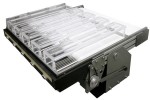Authors
O. Perrot, D. Laroche, T. Pozzo, C. Marie.
Lab
INSERM, U887, Motricité-Plasticité, Dijon, France.
Journal
Behavioural Brain Research
Abstract
Although the rat has become the favourite animal model in preclinical research on locomotion, studies designed to assess the strategy used by rats to avoid obstacle are lacking. Using an optoelectronic 3D motion analysis system, we therefore, compared the step pattern, timing and length variables of locomotor cycles, trajectories and joint angles of limbs when rats step between and over obstacles (3 cm-high) fixed on a treadmill belt (25 cm/s). Motion in all four limbs of adult animals with an initial age of 11 weeks was serially recorded for a period of 10 weeks. The results showed that obstacle clearance is associated with the reorganization of the basic step pattern resulting in increased stride length of all limbs, increased duration of the swing phase of the hindlimbs only, and the appearance of two quadrupedal stance phases. They also revealed that the elevation of limbs above the obstacle not only involves flexion but also displacement of the corresponding girdles. Remarkably, the trajectory of the trailing forelimb to get over the obstacle is almost a mirror image of the trajectory of the leading forelimb. Lastly, all of the parameters measured remained stable over the observation period during which body weight gain reached 100g (one third of the initial body weight). In conclusion, our study may provide a basis for future studies aimed at understanding the neural pathways involved in pathologies associated with deficit/recovery of challenged locomotion in rats.
BIOSEB Instruments Used:
Treadmill (BX-TM),Passive avoidance (LE870)

 Pain - Thermal Allodynia / Hyperalgesia
Pain - Thermal Allodynia / Hyperalgesia Pain - Spontaneous Pain - Postural Deficit
Pain - Spontaneous Pain - Postural Deficit Pain - Mechanical Allodynia / Hyperalgesia
Pain - Mechanical Allodynia / Hyperalgesia Learning/Memory - Attention - Addiction
Learning/Memory - Attention - Addiction Physiology & Respiratory Research
Physiology & Respiratory Research
 Pain
Pain Metabolism
Metabolism Motor control
Motor control Neurodegeneration
Neurodegeneration Cross-disciplinary subjects
Cross-disciplinary subjects Muscular system
Muscular system General activity
General activity Mood Disorders
Mood Disorders Other disorders
Other disorders Joints
Joints Central Nervous System (CNS)
Central Nervous System (CNS) Sensory system
Sensory system Bioseb on booth #14 at OARSI 2024 in Vienna
Bioseb on booth #14 at OARSI 2024 in Vienna 
